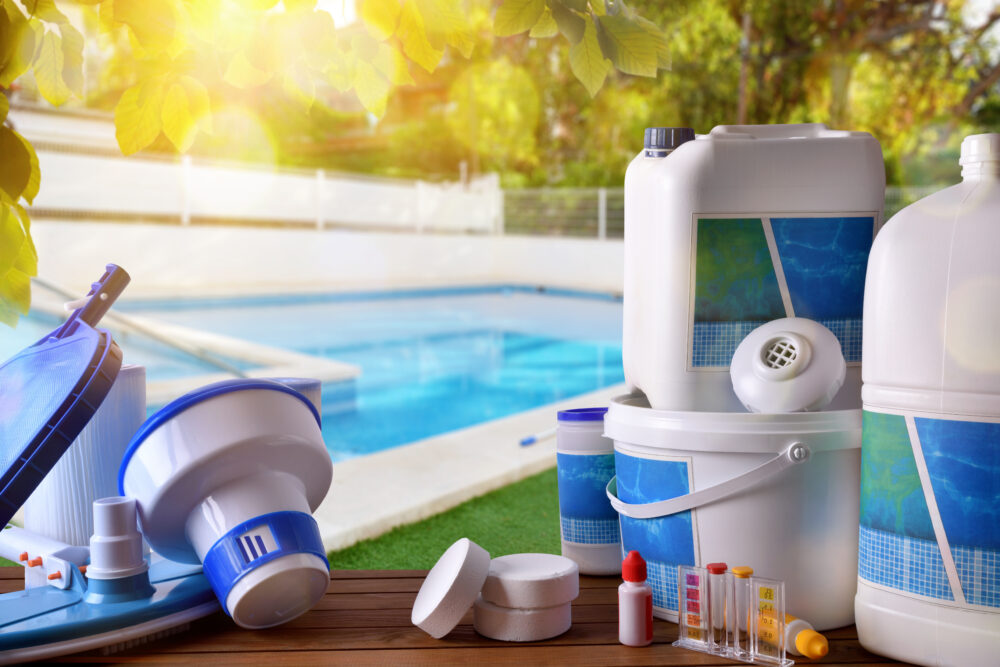Balancing Pool Chemicals: Your Key to Crystal Clear Water
Crystal clear pool water doesn’t happen by accident. Behind every sparkling backyard oasis lies a carefully orchestrated balance of pool chemicals working in perfect harmony. Yet for many pool owners, managing this delicate chemistry feels like conducting a symphony while blindfolded—one wrong note and the entire performance falls flat. Recent industry data reveals that 73% of pool maintenance issues stem from improper chemical balancing, leading to cloudy water, algae growth, and equipment damage that could easily cost thousands in repairs.
At Aqua Bright Pool Service, we’ve witnessed firsthand how proper chemical management transforms problematic pools into pristine retreats that families can enjoy with complete confidence. The good news? Understanding the fundamentals of pool chemistry isn’t rocket science, and with the right approach, you can maintain that perfect balance week after week.

The Foundation of Perfect Pool Chemistry
Think of your pool’s chemical balance as a three-legged stool. Remove any one leg, and the entire structure becomes unstable. The three essential components—pH levels, chlorine concentration, and total alkalinity—must work together to create an environment that’s both safe for swimmers and hostile to unwanted microorganisms.
Your pool’s pH level serves as the master controller, determining how effectively every other chemical performs its job. When pH drifts outside the ideal range of 7.2 to 7.6, even perfectly measured chlorine becomes significantly less effective. It’s like trying to clean your house with diluted soap—you might be using the right amount, but the results will disappoint.
Understanding Chlorine’s Critical Role
Chlorine acts as your pool’s tireless guardian, working around the clock to eliminate bacteria, viruses, and other contaminants. However, maintaining proper chlorine levels requires more nuance than simply adding shock treatment when the water looks questionable. Free available chlorine should consistently measure between 1.0 and 3.0 parts per million, with levels toward the higher end during peak swimming season or after heavy rainfall.
The relationship between chlorine and pH creates what professionals call the “chemical dance.” As pH rises, chlorine’s sanitizing power diminishes exponentially. At a pH of 8.0, your chlorine operates at only 22% efficiency compared to its performance at the optimal 7.4 level. This explains why some pools seem to consume chlorine like a thirsty sponge despite regular additions.
Total Alkalinity: Your Pool’s Shock Absorber
Total alkalinity functions as your pool’s built-in buffer system, preventing dramatic pH swings that can wreak havoc on both water quality and equipment longevity. Maintaining alkalinity between 80 and 120 parts per million creates a stable foundation that allows other chemicals to perform their intended functions without constant adjustment.
When alkalinity drops too low, your pH becomes erratic, bouncing unpredictably with each chemical addition or environmental change. Conversely, excessive alkalinity locks pH in place, making necessary adjustments nearly impossible and often leading to scale formation on pool surfaces and equipment.
The Weekly Maintenance Advantage
Professional weekly pool chemicals services transform chemical balancing from a reactive scramble into a proactive science. During each visit, trained technicians test and adjust multiple parameters simultaneously, catching potential problems before they manifest as visible water quality issues or expensive equipment repairs.
This systematic approach yields compound benefits over time. Consistently balanced water requires fewer emergency chemical corrections, extends equipment life, and maintains the comfortable swimming conditions that make your pool a true backyard retreat rather than a source of ongoing frustration.
Recognizing When Professional Help Makes Sense
While basic chemical maintenance falls within most homeowners’ capabilities, certain situations call for professional expertise. Persistent algae problems, equipment malfunctions, or water that resists standard treatment protocols often indicate underlying issues that require diagnostic skills and specialized knowledge.
Professional pool technicians bring both experience and testing equipment that surpasses typical home testing kits in both accuracy and scope. They can identify subtle imbalances that might escape detection until they develop into more serious problems, ultimately saving both time and money through preventive intervention.
Your pool represents a significant investment in your family’s enjoyment and your property’s value. Protecting that investment through proper pool chemicals maintenance doesn’t require a chemistry degree, but it does demand consistency, attention to detail, and the wisdom to seek professional guidance when needed. Contact Aqua Bright Pool Service today to discover how our weekly maintenance programs can transform your pool from a chemistry challenge into a source of pure relaxation.
